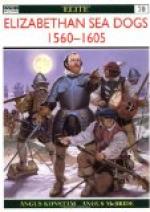Henry’s reasoning and his people’s instinct having led to the same resolve, everyone with any sea-sense, especially shipwrights like Fletcher of Rye, began working towards the best types then obtainable. There were mistakes in plenty. The theory of naval architecture in England was never both sound and strong enough to get its own way against all opposition. But with the issue of life and death always dependent on sea power, and with so many men of every class following the sea, there was at all events the biggest rough-and-tumble school of practical seamanship that any leading country ever had. The two essential steps were quickly taken: first, from oared galleys with very little sail power to the hybrid galleasse with much more sail and much less in the way of oars; secondly, from this to the purely sailing galleon.
With the galleon we enter the age of sailing tactics which decided the fate of the oversea world. This momentous age began with Drake and the English galleon. It ended with Nelson and the first-rate, three-decker, ship-of-the-line. But it was one throughout; for its beginning differed from its end no more than a father differs from his son.
One famous Tudor vessel deserves some special notice, not because of her excellence but because of her defects. The Henry Grace a Dieu, or Great Harry as she was generally called, launched in 1514, was Henry’s own flagship on his way to the Field of the Cloth of Gold in 1520. She had a gala suit of sails and pennants, all made of damasked cloth of gold. Her quarters, sides, and tops were emblazoned with heraldic targets. Court artists painted her to show His Majesty on board wearing cloth of gold, edged with the royal ermine; as well as bright crimson jacket, sleeves, and breeches, with a long white feather in his cap. Doubtless, too, His Majesty of France paid her all the proper compliments; while every man who was then what reporters are to-day talked her up to the top of his bent. No single vessel ever had greater publicity till the famous first Dreadnought of our own day appeared in the British navy nearly four hundred years later.
But the much advertised Great Harry was not a mighty prototype of a world-wide-copied class of battleships like the modern Dreadnought. With her lavish decorations, her towering superstructures fore and aft, and her general aping of a floating castle, she was the wonder of all the landsmen in her own age, as she has been the delight of picturesque historians ever since. But she marked no advance in naval architecture, rather the reverse. She was the last great English ship of medieval times. Twenty-five years after the Field of the Cloth of Gold, Henry was commanding another English fleet, the first of modern times, and therefore one in which the out-of-date Great Harry had no proper place at all. She was absurdly top-hampered and over-gunned. And, for all her thousand tons, she must have bucketed about in the chops of the Channel with the same sort of hobby-horse, see-sawing pitch that bothered Captain Concas in 1893 when sailing an exact reproduction of Columbus’s flagship, the Santa Maria, across the North Atlantic to the great World’s Fair at Chicago.




